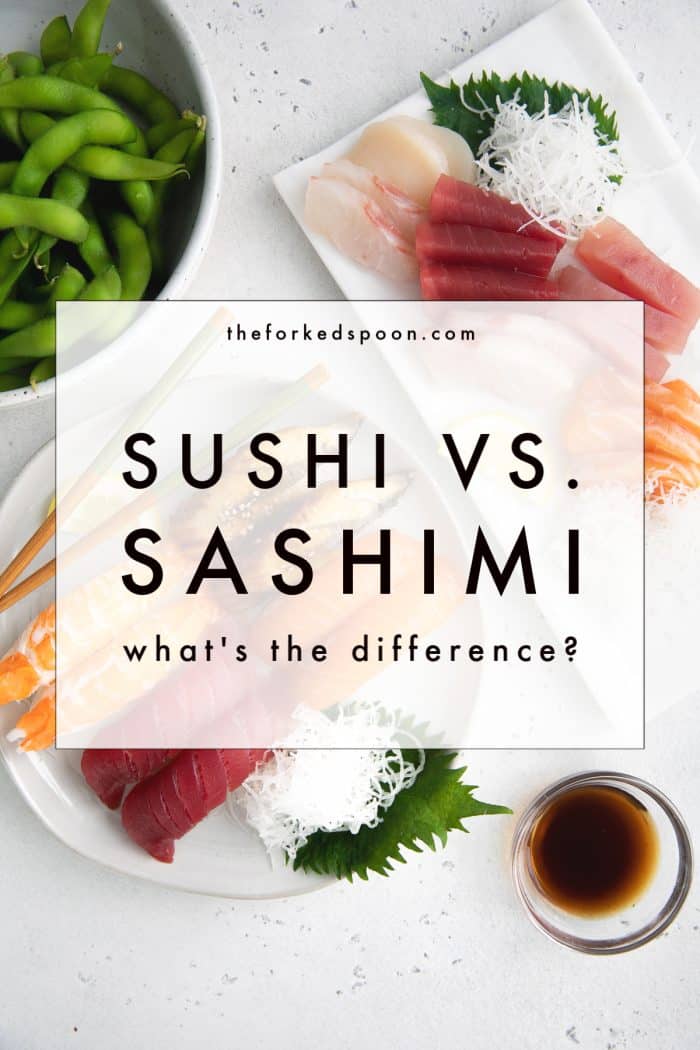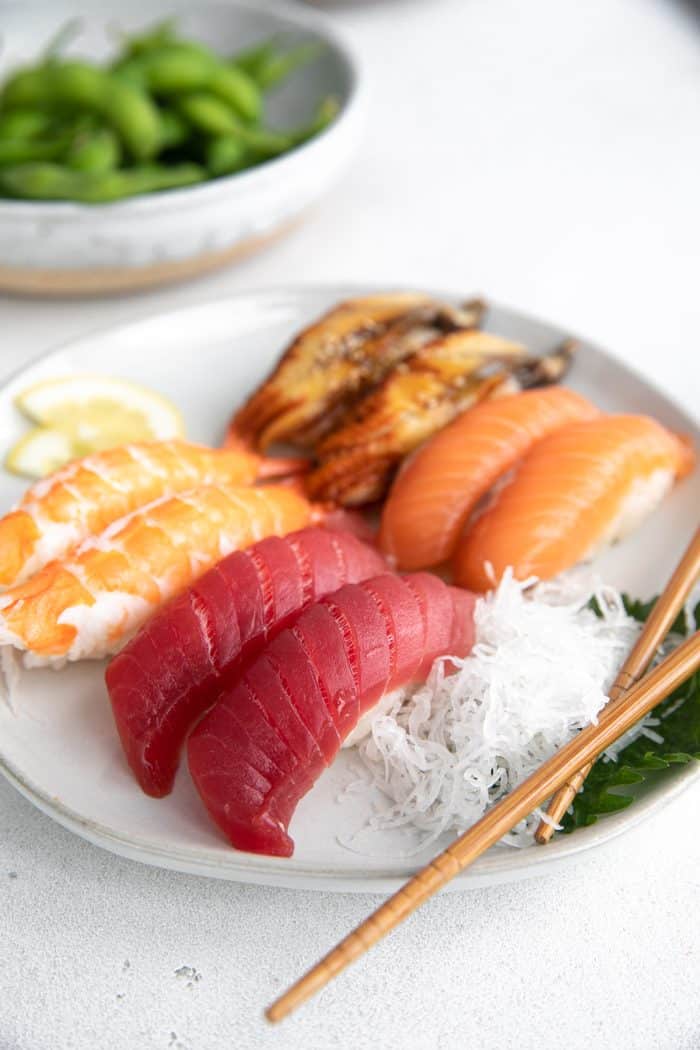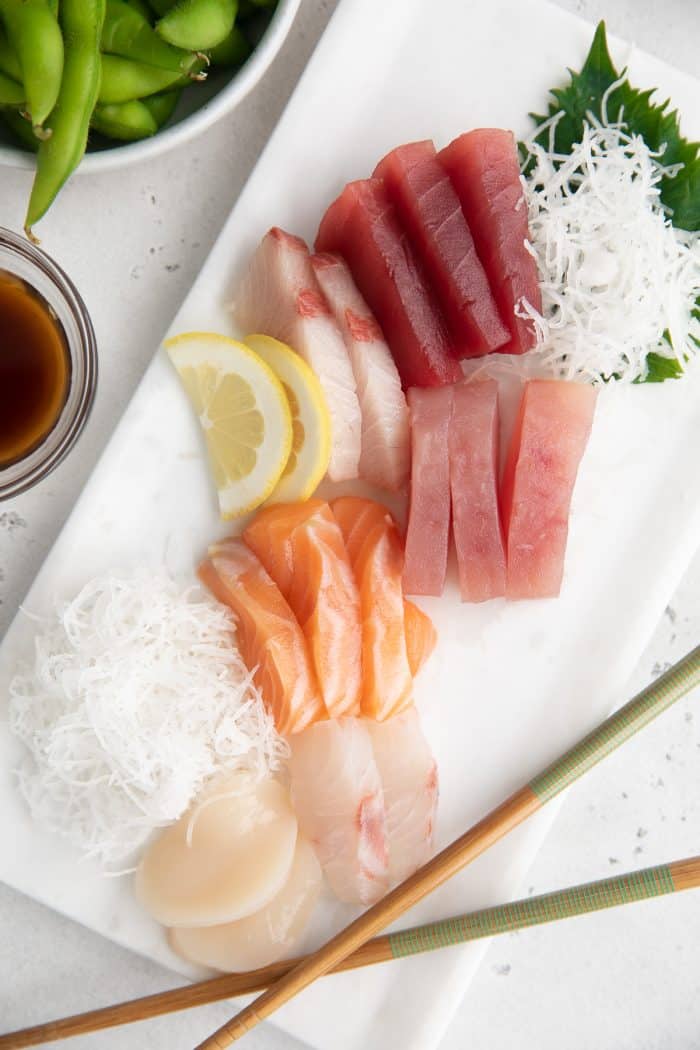Going out for sushi with friends and family is a delicious treat. But for most of us, interpreting the menu feels like a confusing guessing game filled with limitless options and varieties. Helping set some of that confusion aside, let’s learn all about Sushi vs. Sashimi: What’s the Difference?

Japanese cuisine has been hugely popular around the world in the 21st century, and sushi is the pinnacle of the craze. The sushi industry has been skyrocketing in revenue and is estimated to grow over $6 billion between 2018 and 2022, according to a report from TechNavio.
Now that sushi is a main course on the global menu; diners are looking to boost their knowledge on the subject and figure out the intricacies of this Japanese delight.
Understanding the difference between Sushi and Sashimi is the perfect starting point for anyone getting into this exciting cuisine. This article will focus on these key categories, but we’ll also explore a few other Japanese dishes you will likely encounter on a sushi restaurant menu.
We’ve explored the world of Ceviche in the Americas and Caribbean, and now it’s time to venture East to see how they handle their fish. Without further delay, let’s dive into our Sushi vs. Sashimi breakdown!
Definitions
Let’s get one thing straight right away: Sushi does not mean raw fish. Cast aside your assumptions about sushi because they are probably off the mark. According to a post from the famous London restaurant You Me Sushi, the term simply translates to vinegared rice.
It may come as a surprise, but the rice is really what holds sushi together, both physically and categorically. In the West, we refer to the entire family of dishes under one umbrella.
Sashimi, on the other hand, refers to high-quality sliced raw fish of any species. There cannot be rice in this dish by definition. Still, it appears on nearly every sushi menu on the planet.
What most people visualize when they think of sushi is really Nigiri, which is a sashimi-style piece of fish placed on top of a mound of vinegared rice. The famous sushi “rolls” so popular in the West are known more accurately as Maki, which can include tons of crazy ingredients wrapped up in rice or seaweed.
We could go on, but these are the core definitions you should know before your next night out at the local sushi spot. You’re already ahead of 99% of diners out there!

Nigiri
History
The story behind Sushi vs. Sashimi could fill volumes, but we’ll give you the quick hits.
An article from PBS explains that farmers were mixing fish with rice as early as the 4th century, to increase the shelf life of seafood through the process of fermentation.
What began as an inexpensive invention of necessity by peasants morphed into an upper-class delicacy as years went on. By the 9th century, Japanese royalty was enjoying pieces of fish fermented in rice and then served with the rice stripped away.
Since this process took months, the resulting raw meat took on an entirely new flavor and was only attainable by society’s most wealthy members.
Sushi innovators found ways to accelerate fermentation time by packing fish in more rice and using weights to press down on the mixture. By the 17th century, this type of sushi was far more accessible to the masses and was enjoyed widely in the downtown districts of Japan’s bustling cities.
Around 1750, the sheet form of seaweed known as Nori was invented and changed the structure of sushi forever. Chefs began experimenting with containing rice, fish, and vegetables in Nori wraps, allowing for a clean and convenient delivery of many different components at once.
Just about a century later, sushi began to take hold in the West, with United States President Ulysses S. Grant enjoying sushi with Japanese diplomats on his trip around the world.
It didn’t take long before American chefs started deep-frying sushi rolls, incorporating cream cheese and putting other crazy ingredients into their creations. While traditional sushi masters may frown upon these developments, there will always be a market for the next wild sushi invention.
Nutrition
When comparing Sushi vs. Sashimi, we can’t avoid the topic of nutrition. We generally think of sushi as a healthy option, but is it true? Let’s check out the calories of some popular sushi and sashimi dishes.
- Cucumber Roll – 200 calories in 6 pieces
- California Roll – 300 calories in 6 pieces
- Naruto Roll (No Rice) – 100 calories in 6 pieces
- Nigiri – 40 to 50 calories per piece
- Sashimi – 20 to 30 calories per piece
As expected, the vinegar rice is really the make or break factor when it comes to the health of sushi. For folks really trying to restrict their calorie intake, Sashimi is going to be their best bet.
Hidden calories in elaborate sushi rolls can also present a roadblock for dieters. Watch out for anything deep-fried or loaded with extra spicy mayo. Sticking with the basics is probably the best way to avoid these traps.
As far as nutrient content goes, raw seafood is one of the best things on planet earth. Healthy fats, moderate protein, and low carbs are the calling card of mother nature’s greatest superfoods.
Look for yellowtail, mackerel, tuna, and eel when ordering your next round of sushi to get some major health benefits. Also, be sure to scoop a bit of spicy Wasabi on your fish to heat things up and boost your metabolism. You can always chew on a piece of ginger to cool things down if your mouth is on fire!
Techniques
We all know that dining out at sushi restaurants can take its toll on the wallet, so many of us are seeking ways to bring these delicacies to the home kitchen. Let’s outline a few basic techniques you can practice at home without years of apprenticeship under the sushi masters of Japan.
- Make sticky sushi rice by combining rice vinegar, salt, and sugar to a freshly cooked pot of short-grain rice. This will give you the main ingredient to make rolls, mounds, or simply enjoy as a side dish. Try shaping the rice into different forms like mini-footballs, which are the foundation of Nigiri. Check out our article on different rice types to pick the best one for your needs.
- Pick up a salmon filet and practice your sashimi and nigiri cutting techniques with a VERY sharp knife. Check out this article from Blade Advisor to gain some insight from the pros. Seek out new types of fish and learn their unique characteristics. Remember to always cut against the grain!
- Purchase a basic bamboo sushi kit, grab some packaged seaweed, and get rolling. With your vinegar rice and a few fresh ingredients like cucumber, avocado, and salmon, you have everything you need to put together quality Maki. It will take a few attempts to make perfect rolls, but they all taste great.
- Look into some of the more unusual types of sashimi like shellfish, experiment with roe, and try different preparations like grilling, boiling, and frying seafood to serve with your rice.
Top Sashimi
If you want to level up your sashimi knowledge, you can start by learning the definitions of the most popular cuts of fish on a sushi menu. Here are the top ten most common types of sushi you’ll see.
- Akami – dark red cut of Tuna with low-fat content, and therefore a low price
- Chutoro – pink, fatty cut of Tuna higher in flavor and demand
- Otoro – the most sought-after Tuna cut with heavily marbleized fat content
- Unagi – freshwater Eel often cooked over an open flame and with sweet soy sauce
- Uni – soft, yellow interior of Sea Urchin served without embellishment
- Sake – bright orange Salmon with a varying range of fat and flavor
- Tako – very thinly sliced Octopus that must be boiled for reduced chewiness
- Hamachi – translucent and delicate Yellowtail with a white, pinkish hue
- Hotate – super sweet and tender Scallops served right out of the shell
- Ebi – Japanese Prawns that can be found at different fat levels and prices
Others include daikon, temaki, and nigirizushi, and more. Memorize these, and you’ll surely impress whoever is joining you at the sushi bar! Don’t be afraid to try items that may be out of your comfort zone. Uni may not look or sound super appetizing, but it is one of the most delicious seafood items out there!

Sashimi
Conclusion
Whether you’re picking up sushi from a local takeout, dining at a high-end restaurant, or rolling up your own Maki at home, you can enjoy your meal more knowing this key history and terminology.
When deciding between Sushi vs. Sashimi, consider if you want something new and innovative or traditional. Think about which dishes fit with your dietary goals. Be aware of the different ingredients that may not be so appealing to your dining partner or kids!
Remember, sushi doesn’t have to be the main course. It can be an appetizer or side dish in a full meal with salads, soups, and more. Check out our Japanese garlic ginger salad recipe if you need inspiration rounding out your next sushi dinner at home.
Don’t be afraid to experiment and work with unfamiliar ingredients. That’s where the magic happens. Most of all, have fun and enjoy it! Check back into The Forked Spoon for more sushi adventures in the future.


Last Updated | 0 Comments